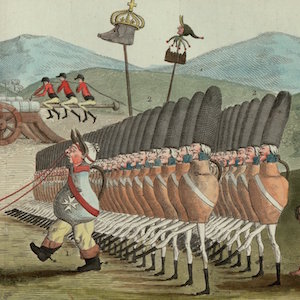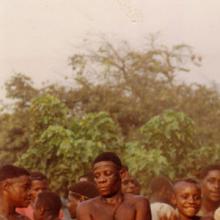Culture

Lady of the Bridge, Tale of Genji Painting Scroll
The greatest work produced during the Heian era was The Tale of Genji by Murasaki Shikibu, lady-in-waiting to Empress Akiko. Considered the world’s first novel, Genji is written as an absorbing portrait of Heian court life, the splendor of its rituals, and aesthetic culture.

The Dream of Malinche
This painting, by a Mexican artist engaged with the international movement of Surrealism, represents a slumbering Malinche; her body serves as the ground supporting an unnamed Mexican community and church.

Mabo Song
This is a written representation of the music from the dance mabo, BaAka music is complex. It is polyphonic (many voices) and polyrhythmic (many rhythms).

Fusillade in the Faubourg St. Antoine, 28 April 1789
This image chronicles a riot. Many believe it was caused by artisans who attacked the Reveillon wallpaper shop and factory because they believed that the owner was about to lower wages. Over two days, more than 6,000 attacked the place. On 28 April troops were called and fired on the crowd.

Fraternity
Using a woman to represent "Fraternity" seems ironic at best, although theoretically the term might mean the community of humanity. In actuality, when the revolutionaries considered "community," they certainly thought of men far more than women.

Transportation of Voltaire to the French Panthéon, 8 July 1792
Although Voltaire’s contribution to the Revolution has been much debated, the revolutionaries themselves had absolutely no doubt of his significance. After 1789 he was much in vogue, in that his plays were often performed and other artists lionized him in various ways.

Army of Jugs
This color drawing, produced in 1793 at the request of the Committee of Public Safety and then published as an engraving, caricatures the British army and its king, George III, as incompetent, who, despite fine uniforms, cannot defeat shoddily clad, yet energetic sans–culottes (on the left), who

Aristocratic Occupations
The second image, a color drawing by the popular English caricaturist James Gillray in 1805 during the Empire, takes a different view of the Directory, suggesting that it is a time of moral decadence and self–aggrandizement.

Analyzing Music
The modules in Methods present case studies that demonstrate how scholars interpret different kinds of historical evidence in world history.

Ah! Monsignor!
Not uncommonly, revolutionary prints invoked excretory humor directed toward those priests who would not swear allegiance to the Revolution. Revolutionaries eliminated on their enemies; the latter might also receive enemas.